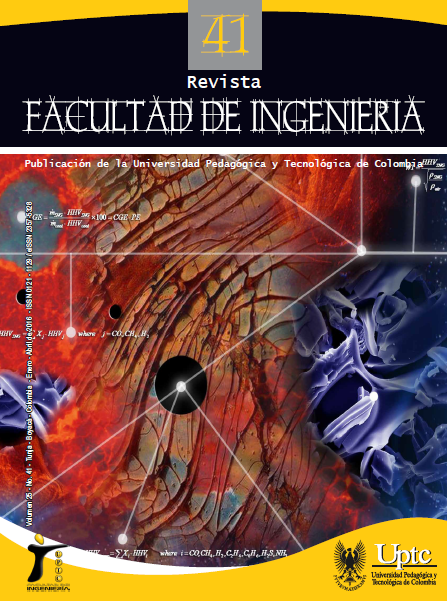Remoción del lubricante adicionado al hierro pulvimetalúrgico, con plasma de la descarga luminiscente anormal

Resumen
Se emplea el plasma de la descarga luminiscente anormal DLA en la remoción del lubricante de compactos de hierro pulvimetalúrgico en atmósfera de hidrógeno, con el fin de establecer las condiciones óptimas del ciclo térmico en la configuración catódica para mantener las propiedades ofrecidas del hierro. Para la preparación de las mezclas se utiliza un mezclador rotatorio. El material se conforma con presión uniaxial en matriz cilíndrica, calculando su densidad y porosidad. Con TGA y DSC se estudian la descomposición térmica y la eliminación del lubricante, luego, se realizan los ciclos de remoción en la DLA. Con TGA se monitorea el estado de remoción del lubricante de cada ciclo en la DLA. Se caracterizan los compactos en verde y los del proceso de remoción con microscopia óptica y SEM.
Se halló una adecuada remoción en la configuración catódica a 400 °C durante 10 minutos, removiéndose la totalidad de lubricante. El ciclo propuesto conviene en aplicaciones industriales por las altas tasas de calentamiento alcanzadas con reducción del consumo de energía, así como de la necesaria en mantener la descarga, referidas a los hornos resistivos utilizados.
Palabras clave
Hierro pulvimetalúrgico, Pulvimetalurgia, DLA, Plasma de la DLA
Citas
- S. Amstrong, M. D. Aesoph and A. L. Gurson, “The Effects of Lubricant Content and Relative Powder Density on the Elastic, Yield and Failure Behavior of a Compacted Metal Powder”, Advances in Powder Metall, Metal Powders Industries Federation, vol. 3, pp. 31, 1995.
- M. Ward, “Influence of Lubricants on Dimensional Changes and Mechanical Properties of Sintered Ferrous Compacts”, Powder Metall. IoM Communications, no. 4, pp. 193, 1979. DOI: https://doi.org/10.1179/pom.1979.22.4.193
- A. I. Lawrence et al., “A performance Comparison of Current P/M Lubricants and Routes to Improvement”, Advances in Powder Metall, Compiled by C. Lall and A.J. Neupaver, Metal Powders Industries Federation, vol. 3, pp. 103, 1997.
- Hoeganaes Corporation, Data Sheet: Ancorsteel 1000, pp. 1-5, 0613-AS1000-D-2.
- Hogänäs AB., Materials and Powders Properties, PoP Application Center of Hogänäs, Handbook No. 1, Chapter 1, 2007.
- Hogänäs AB., Compacting of Metal Powders, PM School, Handbook No. 2, Chapter 4 and Chapter 6, 2007.
- A. Bolarín et al., Análisis Termogravimétrico del Proceso de Eliminación de Lubricante en Compactos P/M”, Centro de Investigaciones de Materiales y Metalurgia - Universidad Autónoma del Estado de Hidalgo (UAEH), Universidad Autónoma de Coahuila, México, 2015.
- M. Ward, “Decomposition Characteristics of some lubricants in iron P/M compacts as a free compounds”, Int. J. Powder Metallurgy and Powder Tech, vol. 3, no. 3, pp. 197, 1977.
- Kuen-Shyang and Li Kuang-Hung, “Lubricant Removal in Metal Powder Compacts”, The International Journal of Power Metallurgy, Vol. 28, no. 4, 1992.
- A. Sarmiento S. y J. L. R. Muzart, “Tratamiento de Acero 316L en Descarga Luminiscente Anormal”, Revista Colombiana de Física, vol. 40, no. 2, pp. 427-429, julio 2008.
- J. L. R. Muzart et al. Advances in Powder Metallurgy & Particulate Materials, part. 3, pp. 77-84, 1997.
- D. Saha and D. Apelian, “Control Strategy for De-lubrication of P/M Compacts”, The International Journal of Powder Metallurgy, Vol. 38, no. 3, pp. 5-7, 13-15, 17-21, 2002.
- G. Randall M., Powder Metallurgy Science, 2th ed., Princeton, New Jersey, U.S.A., Metal Powder Industries Federation, 1994.
- Struktol Company of America, Technical Data.
- Arnaud Gateaud, Physical and Chemical Mechanisms of Lubricant Removal During Stage I of the Sintering Process, Directores: Diran Apelian, Richard D. Sisson, Thesis Degree of Master of Science in Materials Science and Engineering, Worcester Polytechnic Institute, 2006.
- D. Saha, De-lubrication during Sintering of P/M Compacts: Operative Mechanism and Process Control Strategy, Directores: D. Apelian, Richard D. Sisson, Thesis Degree of Master of Science in Materials Science and Engineering, Worcester Polytechnic Institute, pp. 5, 2001.
- E. Hryha et al., “Influence of the Steel Powder Type and Processing Parameters on the Debinding of PM Compacts with Gelatin Binder”, Journal of Thermal Analysis and Calorimetry, Vol. 118, Issue 2, pp. 695, november 2014. DOI: http://dx.doi.org/10.1007/s10973-014- DOI: https://doi.org/10.1007/s10973-014-3839-7
- -7.